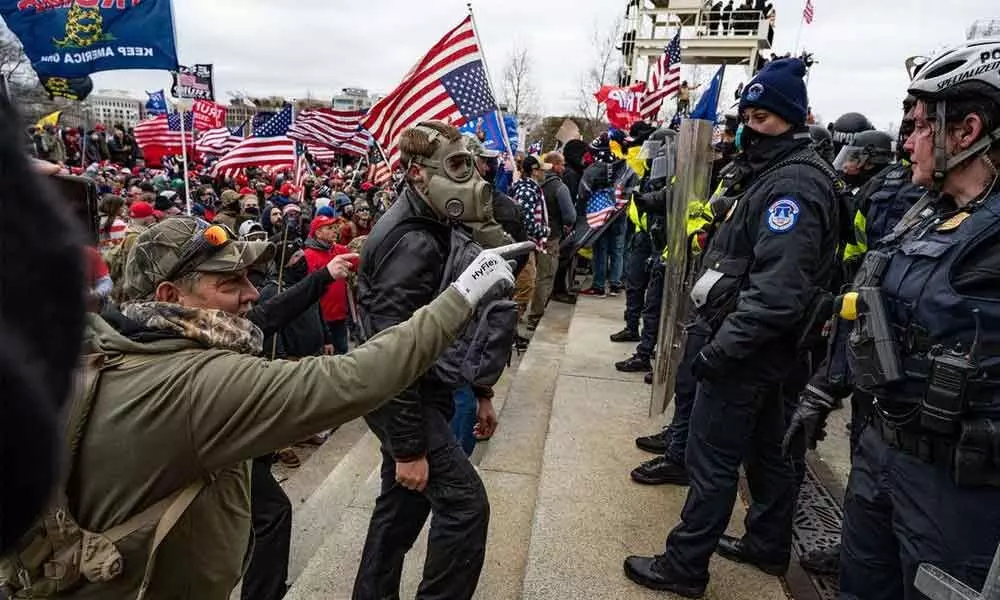A fear perspective on Capitol Hill attack

A fear perspective on Capitol Hill attack
The 6th of January attack on Capitol Building in Washington D. C. reminds me of 2001 terrorist assault on Indian Parliament Building in New Delhi
The 6th of January attack on Capitol Building in Washington D. C. reminds me of 2001 terrorist assault on Indian Parliament Building in New Delhi. The main difference between the two events is that the culprits in the former incident were reported to be the supporters of a long-standing American political party and in the case of the latter, the intruders belonged to banned international terrorist organisations.
Another difference is that the Capitol Hill attackers stormed the building in public view as though they did not care about the law of the land deliberately whereas the terrorists sneaked into the Indian Parliament Building premises secretively in order to execute their diabolical plans.
In both the instances, security forces were successfully able to counter the nefarious efforts of the culprits before more damage could take place. However, the biggest question following the unfortunate Capitol episode that left every right-thinking American citizen perplexed was as to who else is secure if the highest governing institution in the country is not safe. Here I see that the instant tragic occurrence is the outcome of many failures on many fronts. First of all, the alleged attackers grossly failed to conduct themselves as reasonably responsible citizens by not taking recourse to innumerable avenues available for venting their grievances peacefully.
On the other hand, the political leaders at the level of mayor or senator or representative failed to hold prompt and sincere negotiations with the mobsters prior to the ghastly incident to mollify the protesters' rash temperaments. Police forces too failed miserably not only in collecting the inputs of intelligence about the potential assembly of huge violent crowd but also in taking preventive action by invoking relevant legal provisions to forestall the thronging.
Though there are many angles to understand the Capitol riots, be it political or socioeconomic or emotional; I think that a fear perspective will yield a balanced analysis as far as security/ law and order shortcomings are concerned.
Fearism and fearology are two terms which deal with the relationship between fear and life and this trans-disciplinary study was independently pioneered and propounded by Desh Subba, a Nepali thinker and R Michael Fisher, a Canadian philosopher.
According to fearist viewpoint, it can be interpreted that the mobsters lacked benign fear (good fear like respect, reverence etc) towards law and custodians of law. Such questionable attitude was not the result of a single day spontaneous affair but that of habitual defiance to constitutional ethos nurtured over a period of time when law seemed be losing its grip over the society at large to keep it in order.
One explanation, inter alia, could perhaps be attributed to repeatedly occurring slack and ineffective enforcement drives by police officers during the ongoing pandemic. Therefore, it was clearly perceptible that the attackers have not taken policemen's lawful authority seriously enough as it should have been while converging at Capitol Hill. The subsequent emboldenment effect resulted in storming and invading the building and the people inside.
It shows that the attackers have apparently developed a deadly sort of reckless lawlessness and irrational fearlessness towards the authority of people's representatives and enforcement officials. This gruesome act put the US government on a red alert to see that such grave eventualities should not recur in future.
The fearological approach looks at the instant public order crisis mainly from four sides of fear. As we know, fear is generally of two opposite strains which are good fear (or benign fear which is positive and respectful) and bad fear (or toxic fear which evokes irrational and harmful feelings). Juxtaposed to fear is fearlessness which, in equal and opposite directions, exists again in benign (rational and good oriented fearlessness) and toxic (irrational and endangering) forms.
The combinations of these four elements determine the extent of people's obedience to law. The state of benign fear co-existing with benign fearlessness will pave the way for the most harmonious and law-abiding society. Toxic fearlessness can be controlled by resorting to inculcation of benign fear to maintain a fair degree of equanimity in social relations during the maintenance of law and order. Toxic fear can be neutralised by applying benign fearlessness to promote righteous freedom and liberty among the people.
Toxic fear and toxic fearlessness will in unison yield the worst kind of chaotic human conditions in the society and the Capitol disaster is a live example. The reason being that the protesters might have most probably developed negative attitudes towards police officers by virtue of various unfortunate past instances. The innocent members of the crowd would invariably tend to adopt illogical mob psychology.
Past events in America would include the recent Minneapolis riots soon after the death of George Floyd in last July at the hands of police officers and the consequent chaotic social scenario across the nation. Toxic fear usually dons the garb of toxic fearlessness as Freudian defence mechanism and hence there was overt and desperate disobedience to law and lawful authorities as witnessed in the Capitol riots.
Given the sad state of affairs that shook America on that fateful day, it is now high time for the US government to take immediate steps to repair not only systemic faults but also the divisive mindsets of the suspect police officers and the racist citizens. And one of such curative measures must include fear management strategies and fearlessness approach as part of solutions.
(The writer is a retired IPS officer and co-author of 'Fear, Law and Criminology' & 'India, A Nation of Fear and Prejudice'. Views expressed are personal)














